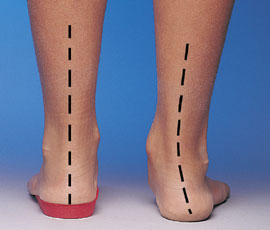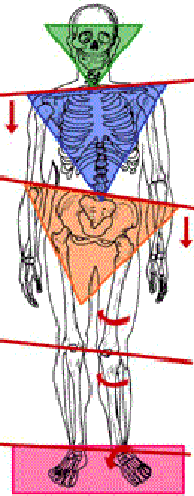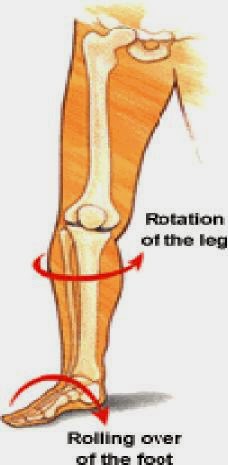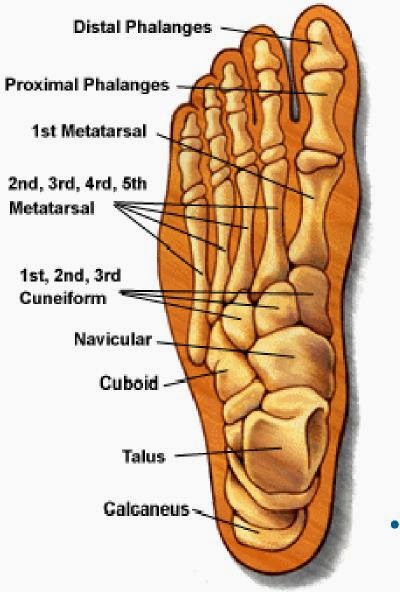Your feet are the foundation of your body
People sometimes wonder how orthotics can correct knee or hip problems. Have you ever had a blister on the bottom of your foot? If you have, you know that you try to avoid putting pressure on it. You change the angle of your foot when you walk and the next thing you know, your knee or hip hurts because you’re walking differently.
Why do people have problems with their feet? It’s simple. The foot is always in motion and under enormous pressure from the body’s weight. As we walk or run, our entire weight lands on our feet, up to 10,000 times a day.
Or, you may have a sore back or hip, and when you alter the way you walk to compensate, your feet begin to hurt. There are many reasons for the aches in the back, legs, and feet – accidental trauma, poorly fitting shoes, or simply signs of age. That’s why people whose feet or legs are not “biomechanically correct” or in perfect alignment, often experience pain in other parts of the body.
Remember, your feet are your foundation. Footmaxx orthotics correct the movement of the foot, and that relieves the problems in the legs, hips and back.
FOOTMAXX ORTHOTICS
Footmaxx orthotics, which are the custom orthotics we use, fit into your shoes. They are similar to insoles, except that they are custom made just for you. These orthotics will correct and improve the way your feet strike the ground. They help your feet move effectively and enhance your natural movement.
Until a few years ago, many orthotics were bulky and that meant people sometimes had to buy special shoes. Not anymore!!! The new Footmaxx orthotics are very thin and lightweight. They fit easily and discreetly into your existing shoes. You can wear your most stylish form-fitting shoes, and still get the proper support and correction from Footmaxx orthotics. They have even come out with orthotics specific for most sports. They have them for hockey, figure skating, skiing, golfing, basketball, baseball, and numerous other sports. Also they have an arthritic and diabetic line of orthotics.
You can learn more about them at www.Footmaxx.com,
email: dr.rodwin@Back2Halth4you.com
or book an appointment with Dr. Barbara Rodwin.
Biomechanics – the physics of movement
We live in an environment that forces our bodies to react to gravitational forces. With every step we take, our skeleton’s alignment and structure influence the process of absorbing and releasing the energy that motion and gravity create. Our feet are highly adaptable. As they hit the ground and begin to absorb load, the motion they undergo is called pronation.
The flexibility of our joints deter-mines how much energy the lower extremity chain (foot-ankle-knee-hip-pelvis-low back) can absorb. For different reasons, both flat and high-arched feet channel a large amount of energy to skeletal structures high in this chain — especially the knee and the hip—making those structures more susceptible to injury
For example, it is common for the kneecap (patella) to develop pain because a flat foot forces the patello-femoral joint to absorb more energy. Running sports add ‘impact loading’ to the equation. Running and jumping amplify the effects of failed biomechanics. Sprains and strains are likely to occur when joints are poorly aligned or when they absorb forces that should be directed to another part of the body.
How Our Feet Work
Your foot is made up of 26 bones that function as a mobile adapter, then as a shock absorber for the rest of your body. During the mobile adapter phase of walking or running, the foot is a “loose bag of bones” that can be placed on any surface and still help maintain the equilibrium of your leg and body above. As adaptable as your foot’s structure must be, it must also be capable of locking itself into a rigid structure so that it can act as a lever, first to stabilize and lift your body’s weight and then to propel it forward.
Why Does The Chiropractor Check Your Feet When Your Back Hurts?
The joints and muscles to the body function most efficiently when they are in physical balance. The body is a biomechanical chain where abnormal movements at one link, or joint, can interfere with proper movements at other joints.
When foot imbalance is present, there is a negative impact on the knees, hips and pelvis, and spine.
Improper balance and function of the feet can lead to a variety of conditions including: excessive rotation of the leg bones stressing the knee and twisting the pelvis and spine.
• Excessive rotation of the leg bones stressing the knee and twisting the pelvis and spine.
• Tilting of the pelvis which places tension on muscles and connective tissue, eventually resulting in chronic back problems.
• High levels of heel-strike shock from breakdown of the body’s natural ‘shock absorbers.’ The shock wave then transmits up the kinetic chain, resulting in painful symptoms up to the head, slowed recovery of leg and spine injuries, and aggravation of other conditions





